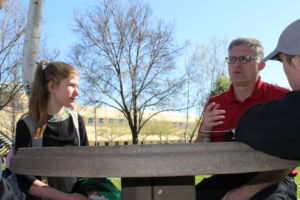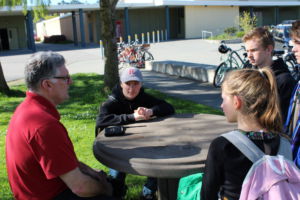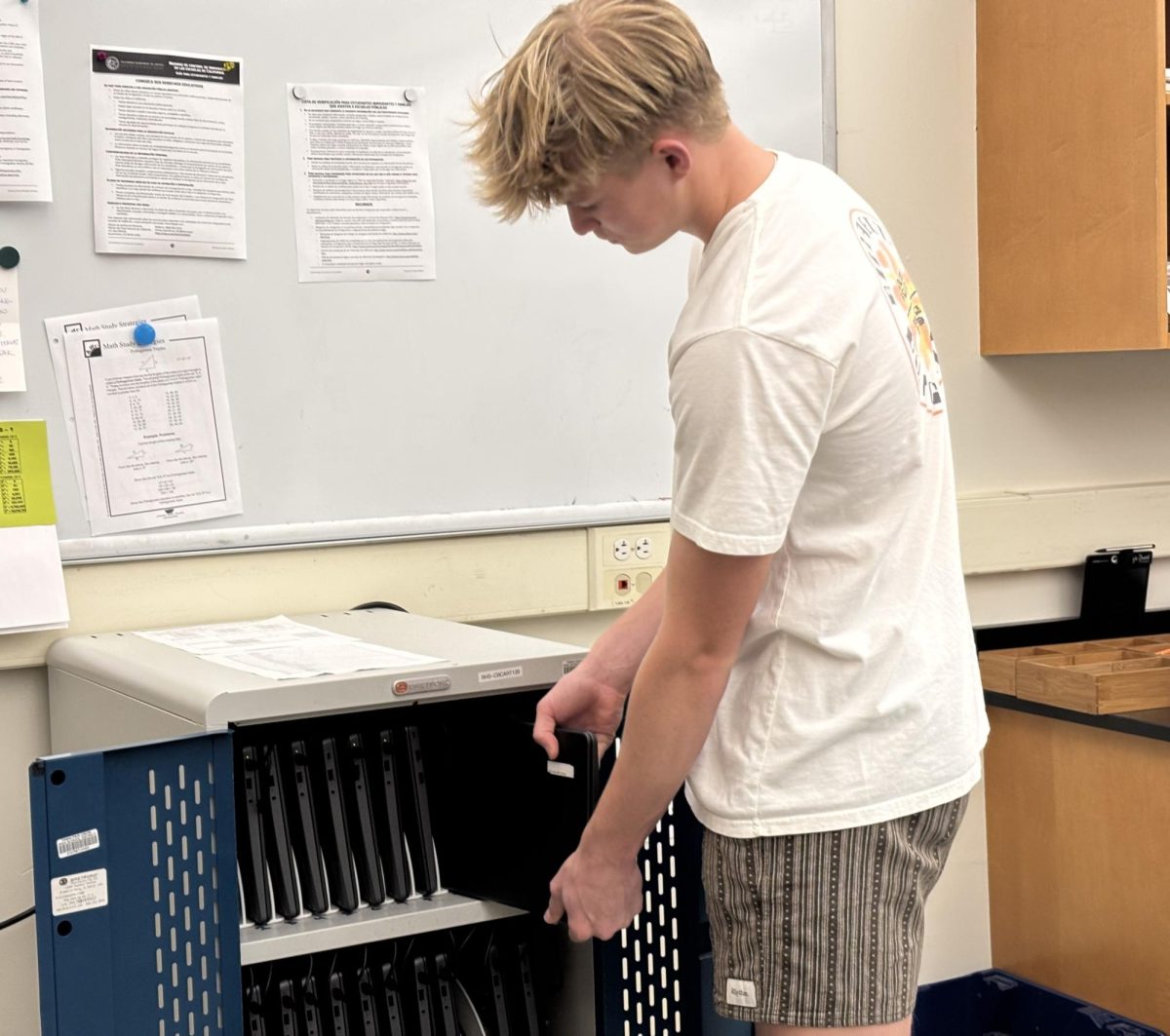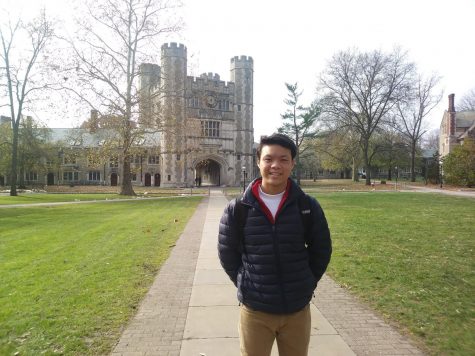On two consecutive Thursdays, March 22 and 29, Principal David Sondheim hosted a meeting for students to discuss school safety during SMART period in his office and outside the small gym. The forums gave students the opportunity to learn about campus security and safety procedures, as well as what these procedures may look like in the future. Sondheim held the first meeting a week after many Redwood students walked out of class on Mar. 14 to advocate for school safety and honor the 17 Parkland students who died in the recent school shooting.
There were three students at the first meeting and five at the second. In the discussions, Sondheim informed the students about potential changes to Redwood safety plans. One possibility, he said, is reforming the current fire evacuation plan. This idea stems from many students’ fears that having a large amount of students in one area could be dangerous. This was seen in the Marjory Stoneman Douglas High School shooting in which the shooter pulled the fire alarm to gather the students into the same location, which allowed mass numbers of students to be shot in six minutes and 20 seconds.
Students who attended the meetings asked questions and voiced their concerns regarding safety at school. Two of these students were sophomore Olivia Raskin and junior Avery Briggs. Briggs said he attended the second meeting because he was curious about different safety procedures in result of the recent threats.

“My main concern was with the bomb threat and [the police’s] level of searching and how long the evacuation took. I was also wondering, with so many shooting threats, when do they consider it legitimate and when do they not and how should we react appropriately to those situations,” Briggs said.
Raskin attended the meeting for a similar reason.
“I went to the meeting because something that was a bit of a concern to me was that we’ve had all of these shooting threats but they’ve never told us what to do in the event of a shooting threat, but it seems like they’re working on that,” Raskin said.
Sondheim said that Redwood will have Central Marin Police Authority (CMPA) Student Resource Officer Scott McKenna spend more time on campus to ensure students’ safety.
“[McKenna] is our main communications person so when we have police issues we’ll normally go through him first. He answers questions, he solves problems and he’ll deal with police matters that interface the school. He also is here to maintain a bridge between our police and our youth,” Sondheim said.
According to Sondheim, McKenna will be armed whenever on duty as per CMPA policy. However, McKenna’s work at Drake, Tamiscal, San Andreas and Hall Middle School, as well as his normal police duties will inhibit him from being at Redwood full time.
Sondheim also mentioned the revised emergency dismissal procedure following the breakdown of the dismissal process during the September bomb threat. In September, students met at the football field and due to the inefficiency of the dismissal plan, some students jumped the fence to leave campus. Sondheim said that once the threat is neutralized, all students will now be released from the football field and can call their parents once they are off campus.
The text and email alert system utilized during the threat will also be revised. In the event of future threats, the school will send out updates every 15 minutes to students, staff and parents in the event of an emergency. These alerts are now set up to give Sondheim the ability to send out mass messages over text, email, the school website and Twitter.
After hearing this, Raskin said she was surprised by the amount of planning that went into these situations.
“I learned that there’s a lot more that goes into the planning of all of the different safety drills and a lot of little things that they have to plan out,” Raskin said.
Another concern students raised was about the new fire evacuation protocol, which involves evacuating to the football field rather than to the field behind the amphitheater. Students felt that the farther distance from classrooms, walking through the parking lot and the congestion caused by the narrow field gates felt less safe than the previous procedure.
Sondheim explained that local police and fire services had brought up concerns about the old plan. Some of these concerns revolved around the proximity of the evacuation location to the art buildings, which could be hazardous because of an active shooting in that area or a fire in those buildings. He also mentioned that the grass slope behind the amphitheater posed a challenge as certain weather conditions would not accommodate for disabled persons. As the area behind the amphitheater is more open than the football field, Sondheim also said that it is more difficult for police to secure before an evacuation, especially with the public paths running behind it.
Despite students’ recent fears, Sondheim said he is confident that having the district’s campus security officers and Officer McKenna at Redwood more often will alleviate some of the worry over school safety.
“I think that having a school resource officer on campus more and having the police close by helps make everybody feel more secure. We certainly appreciate the support,” Sondheim said.

According to Sondheim, another possibility, although unlikely, would be to make Redwood a closed campus as other schools around the country have done in light of recent events. This would most likely entail fencing around the entire campus and controlled entry and exit points. Sondheim is not in favor of this idea because he said that it would not have much of an impact in high-risk situations, would be costly for the district and would eliminate student parking spaces.
“Our campus is a large campus, and to actually make it more of a closed, secure campus would not be physically feasible here. I don’t think that given the way our campus is laid out it would even stop people the same way we hope it would. If someone wants to get through, there are ways to get through,” Sondheim said.
Sondheim also said that all staff are trained on how to handle various emergency situations such as fires, earthquakes and lockdowns through an Emergency Guidelines packet.
“We do the drills and practices so that they can practice what it is they need to do in those situations and we can identify challenges that might happen in real situations and try to problem-solve,” Sondheim said.
By the end of the second meeting, Briggs said he was pleased with what he had learned.
“[Sondheim] answered every single one of my questions and more. I was satisfied by the end of this meeting. I definitely feel a lot better after knowing this information,” Briggs said.
Raskin was also impressed from what was covered and what Redwood is working on in order to improve these plans.
“I definitely saw that [Redwood] is putting in a lot of work and planning out new safety procedures, which is good to know,” Raskin said.
At the end of both meetings, Sondheim said that the school’s top priority is to keep its students safe.
Students who have any other questions about school safety procedures are encouraged to talk to Sondheim in his office or in the halls, as well as email him at dsondheim@tamdistrict.org.







